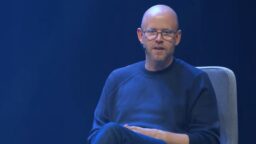The following MBW op/ed comes from Dublin-based Barry Scannell (pictured), a consultant lawyer with Ireland-based law firm, William Fry LLP, which specialises in legal and licensing issues relating to the music industry and technologies such as AI, the metaverse and blockchain.
In the music industry, as artificial intelligence (AI) creative technologies become more common, the question of AI authorship is particularly important. AI systems have the potential to cause disruption in the music industry, and the music industry must adapt and incorporate this new technology.
The idea that a picture tells a thousand words is especially apt when one attempts to outline copyright and authorship issues for works created by AI. What makes this picture interesting, is that it was ‘created’ by an AI.
This picture was created by the DALL·E 2 platform from OpenAI, which is a new AI system that can create realistic images and art from a text prompt description in natural language.
This image was ‘created’ by inputting the text prompt “In the style of Van Gogh, a guitarist in a rock band creating a nuclear supernova with their music, and the crowd is ecstatic”. The AI then used the text prompt to create the image.
In order to use OpenAI’s platform, you must agree to its terms and conditions, which state that users assign any ownership they have in any images created on foot of their prompts by the system, and in turn, the users have an exclusive licence to use the images for any purpose. Other AI platforms which can generate works have similar contractual copyright and licensing arrangements.
What is interesting to consider, is who is the author of this image? Was it the person who input the text prompt? Was it the AI? Was it the developer of the AI or the company that owns the AI? The tricky aspect of AI authorship is that most jurisdictions require a human to be the author, and a work is only capable of being protected by copyright if it shows intellectual effort, creativity, and reflects the author’s personality.
As AI creative systems become more widespread, we must consider whether a text prompt such as the ‘nuclear supernova’ one above constitutes enough human input, and is sufficiently creative and reflective of the human author’s personality to allow the resulting image to be protected by copyright.
If it is the case that the courts decide that not enough human input goes into an AI-generated work, then that work cannot be protected by copyright (with notable exceptions such as UK and Irish law permitting copyright protection of computer-generated works, with the author being the person who made the “necessary arrangements” for the creation of the work), and then the work will fall into the public domain.
These technologies are based on deep learning and reinforcement learning architectures. What’s relevant to the discussion of AI compositions is how the AI was ‘trained’. With AI technologies based on machine learning (as AI composition technologies are), the AI must be trained so that it can learn and adapt to be able to generate compositions.
The training data for AI is particularly important when it comes to creative works, as it could involve rights issues, licensing issues and other copyright considerations, given that the training data is usually based on musical works.
Training an AI on classical compositions which are public domain largely avoids an infringement risk, provided that the sound recording right (if a sound recording is being used) is public domain or is properly licensed. The issue is, what if an AI system is trained on musical works which are protected by copyright but no authorisation has been provided to exploit the works in this way?
Text and Data Mining (TDM) is an automated process of selecting and analysing large amounts data resources for purposes such as searching, finding patterns, discovering relationships, semantic analysis, which can be used for machine learning. When training an AI on musical works, TDM algorithms are applied, which more often than not requires reproductions of the works to be made.
The data extracted by TDM is then used to train the AI systems. Problematically, if an AI system is trained on copyright works, even if no remuneration is paid to the copyright owner, the subsequent works produced by the AI could potentially compete against the existing human created works.
“These technologies could also potentially replace background music in public, in venues such as cafés and bars, as the quality of the AI compositions improve, potentially disrupting important public performance revenues for authors and composers.”
It would not be unreasonable to assume that copyright owners would be protected by copyright in this scenario, but various new pieces of international legislation provide exceptions for the reproduction right for copyright works so that such works can be used for TDM without authorisation , such as in Japan, where the exception exists, provided the rights of the rightholder are not unduly prejudiced. In the EU, the exception is even more wide ranging, as it applies only unless the rightholder has expressly reserved their rights in relation to TDM in “an appropriate manner”.
As with all new technologies, creative AI may have a disruptive effect, e.g. audio-visual producers may instead opt to rely on AI technologies instead of hiring a composer. These technologies could also potentially replace background music in public, in venues such as cafés and bars, as the quality of the AI compositions improve, potentially disrupting important public performance revenues for authors and composers.
However, provided that the correct legal arrangements are in place and rights are being adequately protected, AI technology ought to be enormously beneficial to the music industry. AI technologies can be, and are, being used by authors and composers and musicians to create new music all the time, and the technology enhances creativity and productivity just as other music technologies have before it.
The music industry needs to make the technology work for itself. AI could be an enormously beneficial technology to the music industry, provided that the underlying infrastructure is in place. This means adequately reserving rights in relation to TDM, creating new revenue streams, and implementing new contractual and licensing regimes which embraces new technology. There are enormous benefits to be gleaned from AI technologies, and creating awareness in the music industry of what AI can do for musicians, authors and composers will be equally as important.Music Business Worldwide




